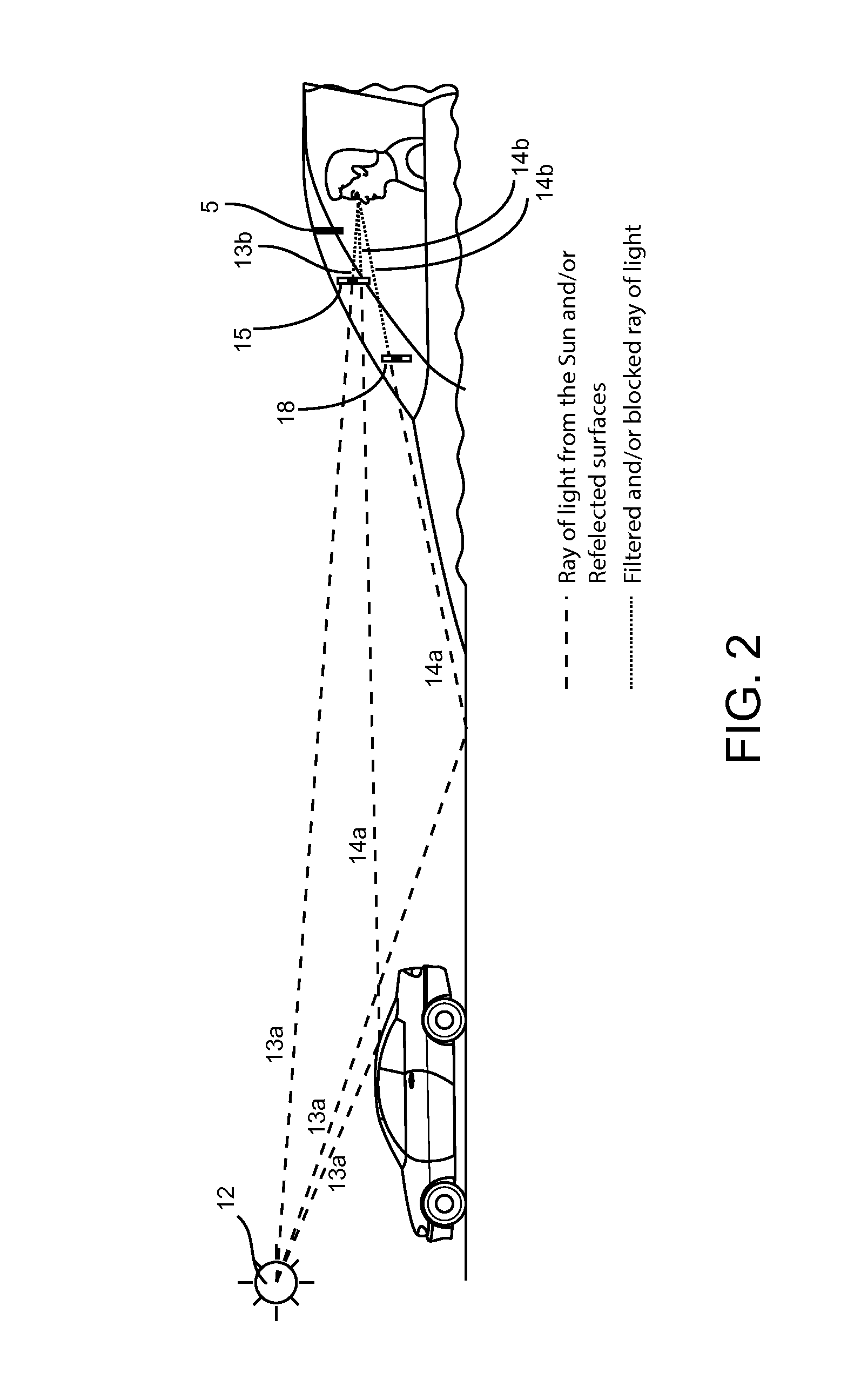Sun tracking tint visor
a technology of sun tracking and visor, which is applied in the direction of antiglare equipment, vehicle components, transportation and packaging, etc., can solve the problems of temporary blindness, damage to the vehicle, impact and subsequent damage, etc., and achieve the optimal level of luminous transmittance, reduce the effect of flash blindness and other distractions, and reduce the effect of sunshin
- Summary
- Abstract
- Description
- Claims
- Application Information
AI Technical Summary
Benefits of technology
Problems solved by technology
Method used
Image
Examples
embodiment 3
[0093]In addition, the user can move the Optical Filter 1 and Darker Tint Strip 2 in a general vertical direction, such as, for example, using an arm. Said arm, hereinafter referred to as “Track Arm”4, is the attachment between the Optical Filter 1 and Darker Tint Strip 2 and the Track Rod 7. In the preferred embodiment of the invention, the Track Arm 4 will move the Optical Filter 1 and Darker Tint Strip 2 in the vertical direction (as illustrated in FIG. 8B). In addition, the Track Arm 4 will contain other components, including, but not limited to hinges, ball and socket joint, spring, piston, slides, etc. that afford the user of the Optical Filter 1 and Darker Tint Strip 2 mobility in a multitude of directions. For instance, the Optical Filter 1 and Darker Tint Strip 2 are secured to the Track Arm 4 by an Optical Filter Adjustment embodiment 3, as depicted in the embodiment in FIG. 16. In such specific embodiment, the Optical Filter Adjustment secures the Optical Filter 1 and Dar...
embodiment 5
[0096]In another situation, in which the sun 12 is at a high position relative to the horizon the present invention is also beneficial for a user. As depicted in FIG. 3, the Optical Filter and Darker Tint Strip assembly embodiment can be positioned in front of a user to filter out various rays of reflected light while using an Auxiliary Darker Visor Embodiment 5 to filter the ray of light 13B from other sources, such as the sun 12. Various surfaces can reflect the rays of light from the sun 12 in varying intensities. The user can utilize the preferred embodiment of the Optical Filter and Darker Tint Strip assembly to block these various rays of light. For instance, a reflected ray of light from a highly-reflective surface 16A, wherein said highly-reflective surface includes, for example, certain portions of another vehicle's windshield or metallic surface, can be filtered by the Darker Tint Strip 16B. At the same time, a reflected ray of light from another surface 14A, can be filter...
embodiment 24
[0128]In addition, the inventor has recognized that the resistance force to move the Sun-Tracking Tint Visor is an important component of the preferred embodiment of the present invention. Such resistance force is needed to ensure that the Optical Filter 1, Darker Tint Strip 2, Track Rod 7, Track Arm 4, and / or other moving components comprising the preferred embodiment of the invention do not unintentionally move during acceleration, deceleration, and turning. In an embodiment, the hinges, ball and socket joint, spring, piston, slides, cables, pulleys, belts and / or other components that afford movement of the Optical Filter 1 and / or Darker Tint Strip 2 can be user-tightened with, such as for example, a clamp and / or tightening screw mechanism. Said tightening screw mechanism may be user-adjusted and / or spring-loaded. Such said user-adjusted tightening mechanism is represented in an illustration in FIG. 12 showing an embodiment of the Sliding Carriage Box. The Sliding Carriage Box emb...
PUM
 Login to view more
Login to view more Abstract
Description
Claims
Application Information
 Login to view more
Login to view more - R&D Engineer
- R&D Manager
- IP Professional
- Industry Leading Data Capabilities
- Powerful AI technology
- Patent DNA Extraction
Browse by: Latest US Patents, China's latest patents, Technical Efficacy Thesaurus, Application Domain, Technology Topic.
© 2024 PatSnap. All rights reserved.Legal|Privacy policy|Modern Slavery Act Transparency Statement|Sitemap



